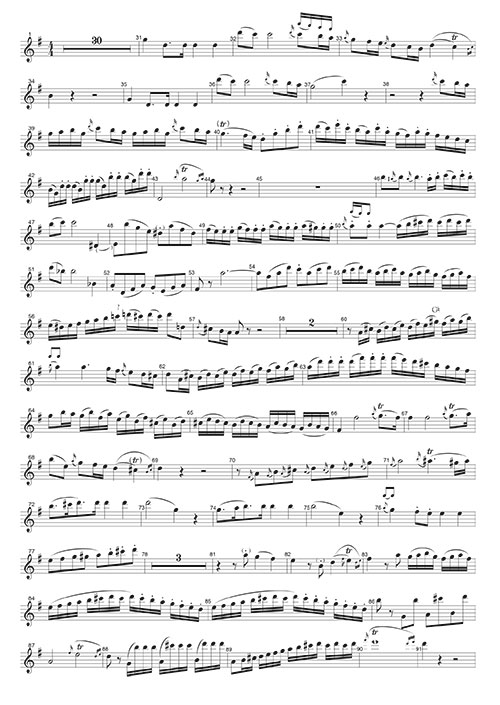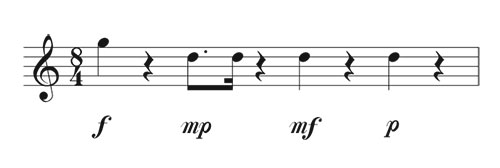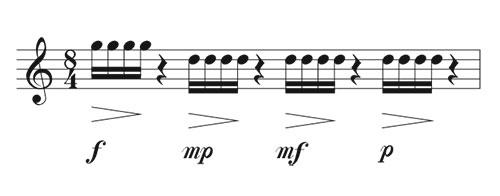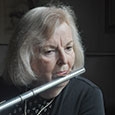The exposition of the first movement of the Mozart Concerto in G for flute and orchestra, K. 313 has become a standard excerpt for almost every kind of flute audition. Even middle school flutists find it on audition lists for youth orchestras long before their technique and musical understanding is advanced enough to play Mozart. There is a saying that has been around for centuries: “Mozart is too easy for students and too difficult for professionals.” This refers to the transparency of the music. It shows up all of a musician’s flaws both technically and musically.
When teaching this, whether for the first or fiftieth time, teachers should tread slowly and patiently. If you don’t, some teacher in the future will spend years undoing bad habits and poor musicianship. The seeds you plant now will pay off in the future.
The concerto was written in January and February of 1778 in Mannheim, Germany as part of a commission by the Dutch flutist Ferdinand De Jean. It is scored for strings and pairs of flutes (second movement only), oboes and horns. It was probably premiered by flutist/composer Johann Baptist Wendling (1723-1797) who, along with his soprano wife, was a frequent performer in the region. The Andante in C, K. 315, may have been written as a replacement for the slow movement.
The first movement is in sonata-concerto form (double exposition, development, and recapitulation). The first exposition (measures 1-30) is played by the orchestra. The flute plays the second exposition (measures 31-91). The development runs from measures 91 through 149 when the recapitulation occurs. A cadenza is improvised in measure 215.
Teach the exposition first, followed by the recapitulation, and finally the development section. Spend as long as six weeks or more on the exposition before moving on. The discipline students develop here will ensure that they understand the musical style when they learn the recapitulation and development sections.
Mozart Concerto in G Exposition

Music Editions
The first complete edition of the works of Mozart was published between 1877-1883 with additional supplements until 1910. This is the scholarship found in older Mozart editions. Between 1955-2011 the Neue Mozart-Ausgabe was published. The scores for the flute concertos plus the Andante in C are in Series V, Band 3. While the scores are not in the public domain in the United States, you may peruse them at dme.mozarteum.at/DME/nma/start.php?l=2. The Packard Humanities Institute has made sharing this new scholarship available to the public. If you do not wish to upgrade to a scholarly edition, you can update an older flute part by comparing it to the score with the new scholarship. If the performance is to be with an orchestra, bowings and articulations should match the flute part so it may be necessary to check the individual parts with the Neue Mozart-Ausgave.
Tempo
The first movement is marked Allegro maestoso. According to Franz Vester in his excellent book W.A. Mozart: On the Performance of the Works for Wind Instruments, Mozart added the words maestoso, moderato, or aperto for calmer allegros. Vester suggests a tempo marking of quarter note = 112. Many conductors rightly alternate conducting this in 4 and alla breve (in 2). Conducting in 2 can create a longer and more interesting musical line.
Shape and Length of the Note
The strongest part of the note is at the beginning, and it should end with a slight taper or decay to the weaker beat. This is based on the strength of the beat concept with one being the strongest beat, followed by three, then two and four in common time. The attack or beginning of the note should be clean and without accent unless one is written in the music.
Unless they are under a slur, notes are played shorter than written. Johann Joachim Quantz (1697-1776) said, “The notes must not appear to be glued together.” The length of a note is affected by the tempo of the passage. This is a difficult concept to teach because players must learn to wait during the silence in order to play on the beat. If they do not wait, then rushing occurs. The shape and the length of the notes are part of defining the classical style.
Prep 1
Begin preparation several months before the study of the exposition. As many a famous flutist has said, “You don’t learn to play the flute on Mozart. You learn to play the flute and then play Mozart.” Technique should be taken care of first. A student’s sound is also a consideration. For a historically informed performance (HIP) that assimilates the scholarship of the past but is performed on a modern instrument, the tone should be of a purer nature without edge. To find this tone Geoffrey Gilbert suggests, “If your lip position is right for the second octave C, then the remainder of the notes below will look after themselves.” In addition to this comment, I have found that using the embouchure position of the third overblown harmonic to be helpful in finding this sound. Playing slurred, left-handed scales with the right hand on the barrel is also useful. (G5, A5, B5, C6, and the repeating these fingerings overblown to the third partial to produce D6, E6, F#6, and G6.)
Have students practice scales, arpeggios, and scales in thirds in G major and the closely related keys (E minor, C major, A minor, D major and B minor) playing four quarter notes to each pitch. The metronome should be set quarter note = 112. Students should practice playing notes shorter than written and also employing the strength of the beat rule of having the first note loud, the second softer, the third note less loud, and the fourth note softest.

Repeat playing all the scales in sixteenths, all slurred and then single and double-tongued. First let the end of the flute notch the notes by beat until students can play them consistently even. Then play the entire scale up and down shifting weight from the back right foot to the left front foot on a horizontal plane. This was a concept first put forward by Robert Willoughby many years ago. He said that flutists play so much moving the flute from down to up (as if naturally breathing and cueing), perhaps they should try moving the flute on a horizontal plane. Playing while shifting the weight forward accomplishes this.
Practice arpeggios in chord progressions such as I V I, I ii V I, I IV V I, etc. to help students learn to hear chord function. Playing etudes by Hugues, Berbiguier, or Andersen in the same closely related keys is also helpful. If there is time, students should study sonatas and concertos by Devienne and Mercadante and other composers from Mozart’s time.
Prep 2
Set the metronome on quarter note = 112. Beginning in measure 31, students should play one beat and then rest one beat. Repeat playing beat two with a rest, then beat three with a rest, and finally beat four. Do this throughout the exposition. It is tedious but after students have done this, teachers know they understand where the beats are in common time.

Next repeat this exercise but fill in the beat with sixteenth notes, double tongued. Be sure the first note of each of the group of four sixteenths is the loudest. And, that the last note of each group is no longer than any of the other notes. This helps students understand interior rhythms. Repeat using the articulations T, Ka, and Hah.

Repeat this idea but play two beats followed by a rest with all of the beats filled in with sixteenths. This practice will help flutists learn to play this movement alla breve rather than in four. It will also help them learn to play with a longer line.
Next, repeat this idea and play a measure followed by a rest with the sixteenths still filling in the written notes. Remind students to follow the strength of the beat rule. Once again, this will also help them learn to play with a longer line.
While practicing Prep 1 and 2, there will be a tendency on both the part of teacher and student to want to move on. Resist this as the exercises are primarily about developing the discipline to execute the music in this manner. It takes repetitive drill to accomplish this. Remember the most important objectives are:
1. Shape of notes
2. Strength of the beat concept
3. Notes are unglued unless slurred.
To make these drills more fun, the teacher and student can alternate ping pong style playing by beat with first the teacher and then the student going first. A benefit of this drill is that students will match their teacher’s sound and energy.
For each of these drills, use a metronome. In performance tempo may deviate some, but for auditions, they expect to hear perfectly accurate rhythm.
When playing with an orchestra, the flutist must project over the other instruments. This offers some challenges because modern orchestras have many more string players than they did in Mozart’s time unless directors use reduced strings.
Concerto dynamics are employed which means the sound should be constructed for the Classical era (with projection) rather than a 20th or 21st century tone color.
Measure by Measure
How many measures a student can assimilate each week will vary. Don’t be in a hurry. If a student can only understand and execute four measures a week, then four measures it is.
Measure 31 employs a rhythm that musicologists refer to as a trumpet motive because of its similarity to a trumpet call. Flutists of earlier generations who recorded this work played the first note long and touching the second note. It almost sounds as if the two notes are slurred. Careful observation shows that the first note should be shortened with an articulatory silence, and the second note should be clearly articulated. If students are listening to recordings from an earlier time, point out the difference in what they hear and what you want the outcome to be. The second beat features a dotted eighth and sixteenth note. Unless there is a slur, which in this case there is not, then the time of the dot becomes a rest. This is what is called playing in a spaced style. The first and the third beats are the strongest and beats two and four are the weakest. Have students crisply sing the words in the style of a military trumpeter “This is a trum-pet m-o-tive” for the opening seven beats to get an idea of the style. Repeat mimicking on the flute.
Measure 32 features a syncopated rhythm. This rhythm is a favorite of Mozart’s and is found throughout his works. With any syncopation, the weak beat is now more important, so put a space or silence both before and after the half-note C. The first beat is a two-note slur, which means that the first note is louder than the second note and also might receive a color inflection by using a faster vibrato speed. The fourth beat is played slur 2, tongue 2. Notice that the fourth note of each group of sixteenths is the same note as the first note of the next group of sixteenths. Repeated notes should be separated so the listener hears two separate notes. Or, shorten the first of the repeated notes so the note of the first group of sixteenths is definitely heard as a new articulated note. Let this downward scale naturally diminuendo as the flutes of Mozart’s time would have done.
The trill in measure 33 ends with an optional resolution (B to C) and the B on the first beat of measure 34 is tongued. The resolution notes are played softer than either the trilled note or the first note in the next measure.
Measures 35 and 36 employ the same phrasing ideas with measure 37 employing a two-note slur which means the C should be softer than the G. Of course, if you are already following the strength of the beat concept, the first beat is stronger than the third beat and would be naturally played softer. When there are two rules to follow (two-note slurs are played loud/soft and the strength of the beat concept), you can be sure that the rules are important. Flutists today with modern instruments are able to play measure 35 with a loud, edgy sound because of the way instruments are built today. For a HIP performance, select a sound or tone with less edge. It might even be one that sounds a bit airy to the performer.
Throughout Mozart’s operas there are passages where the music on the stage passes to the orchestra and then back again. This occurs on the fourth beat of measure 37 into measure 38. Then the flute enters with a rhythmic hemiola with the strong idea being on beat four, beat two, and then beat four before cadencing in measure 40. With each repetition, flutists often make a slight crescendo by two beats in a style reminiscent of the Baroque terraced dynamic.
The trill in measure 40 begins on the G because the note before is an A. The passing tones are slurred in with the trill and the third beat is newly articulated. The trumpet-like arpeggio at the end of the measure leads into two measures of sixteenth notes before the cadence to end this statement. Playing these sixteenth notes phrased by eights rather than by fours will improve the line. The trill in measure 43 begins on a B, but be sure that the B is on the beat and not before. Some flutists make the B slightly longer, but I prefer it to be in the time of the trill.
The next entrance is in measure 46 in the key of E minor. The key change suggests a change of mood. The grace notes are played as an acciaccatura (notated today with a slash through the stem) which means it is played before the beat but as close to the beat as possible. The acciaccatura is slurred to the principal note. Have students play the first two beats several times without the acciaccatura so they realize that there are three repeated pitches. Following the strength of the beat rule, the first B is the loudest, and the third B or the one on the second beat is next loudest. The one on the and of one is the softest. The sixteenths at the end of the measure should be thought of as a pick up to the next measure where once again Mozart employs one of his favorite syncopated measures. The second beat C should be separated by articulatory silences from beats one and four. Beat one has a two-note slur which should be played loud/soft. The fourth beat D# is the leading tone in E minor and should receive a color as it resolves (with a slur) into the E in the next measure.
Notice in measure 48 how Mozart separates the D# out again with the use of articulation to imply compound melody. Measure 49 employs a sequential figure of slur two, tongue two up the scale. Let the notes naturally crescendo by beat as they ascend. The grace-note in measure 50 could be played evenly or in a short/long (Scottish snap) relationship. The main thing is to be sure the first note B is on the beat and not before. The sixteenths at the end of measure 50 are leading into measure 51 and should be played a bit softer but with energy leading into the next down beat.
The first beat D in measure 51 should be carefully placed on beat one. Notice the note in the measure before is also a D, so it is easy to get this note connected into the one in the next measure. Remember that all repeated notes are played in a separated fashion with some kind of dynamic design. Measure 51 is a repeat of the syncopation found earlier. The first beat is a two-note slur which is played loud/soft. The B flats are color notes showing the difference from the earlier G major to this measure of G minor, the parallel minor key. Follow the articulation in measures 52 and 54 to show the one articulated note. The Neue Mozart suggests slurring by fours in the sequential pattern in measure 55. Since the principal beat notes decline, let the dynamic decline also. In measure 56, I like to add a slur on the first two sixteenths because it balances my right hand well. There is a question whether note number eight in the measure should be a C natural or C sharp. If flutists always play just the flute part, their ear will gravitate to a C#; however, if the note is aligned with the accompaniment of a repeated E minor chord, the C natural is a better fit. The loudest note in this measure will be the first D on the third beat. Then let the volume come down to follow the contour of the melody as you move into measure 57. Be sure there is space or an articulatory silence between the D on the last beat of measure 56 and the first D in measure 57.
The flute enters again in measure 60 with scales in thirds. The Neue Mozart edition suggests slurring the thirds by twos. Remember the lower note of the slur is the more important one. Sometimes thinking of the lower notes as a scale horizontally helps flutists achieve this. There is a question about whether the third beat in measure 60 should be a Gn or G#. Many flute parts suggest a G#; however, in the Neue Mozart it is a Gn. I would argue for the Gn because in the measure before, the oboes and violins have the same third passage with a Gn. Technically playing a Gn is much easier than playing a G#.
In measure 61, the grace note can either be played as an acciaccatura or as two even notes. Whichever you select, the first note is louder than the second note, and the first note should be on the beat. There is an A on beats one and two. The A on beat one is more important than the one on beat two. You might try playing a different fingering for the second A to change the timbre or color of the note. Try adding the G# finger or the F finger to the A fingering or add both. Select which is easiest to navigate. The grace note on beat four should be played as a sixteenth just as in measure 36. These measures are played as two bar phrases: measure 60 and 61 and then 62 and 63, and 64 and 65. Breathe after the first eighth note in the even numbered measures.
Once again measures 66 and 67 feature a syncopation; so, use separation or articulatory silence between the half notes on beat two and beat one or four. The trills on the fourth beats in these measures begin from the upper note. Be sure this upper note is on the beat and not before.
The thirds in measure 70 are written differently from the other thirds in the exposition. The grace note should be played as an acciaccatura before the beat yet as close to the beat as possible. Once again, the flute entrance is mimicking what the oboes and violins have just played. In measure 71, the trill on the third beat begins from a B natural and is slurred through the measure. The first note in measure 70 is articulated.
The fourth beat of measure 72 is a weak beat and the two slurred notes in measure 73 are played strong/weak. Have the student sing “I Love you” on these three notes to get the proper inflection. This is repeated in measures 74 and 75. When there is a direct imitation, consider playing a dynamic echo, but, whatever you decide, do not play them exactly the same. The grace note in measure 76 may be played evenly or in a Scottish snap rhythm. The rising scale in measure 77 should lead to the A and then taper into the clouds. Here the flute is leading into the orchestra accompaniment to complete the phrase.
In every piece by Mozart, there is a place where for just a moment he lets you see his soul. I think measures 81-84 are just that. The orchestral part is very vocal, and the viola part is totally interesting in its figuration. Try singing “Are you o-kay? Yes, I am fine” to the first violin line. When the flute enters to repeat the melodic material one octave higher, sing again “Are you o-kay? Yes, I am fine.” If you take the A on the upbeat of the second beat and then the first sixteenth of the third and fourth beats, you have an ornamented version of measure 81. Color the melodic outline notes. In measure 84 and 85, play the sixteenths phrased by eights so there is a long line.
In measure 86, the tenths are written to show virtuosity. They are much easier to execute on the modern flute than on a traverso, so play them with care and not flippancy. The lower note is more important than the upper note. In measure 87, the trill begins from the upper note F# and is played on the beat, not before. Measure 88 features the same tenth as measure 86, but filled in with sixteenth notes. The first note in measure 89 is played shorter than an eighth note to allow the gesture to change from down/up to forward flow. The sixteenths lead to the cadential trill in measure 90. This standard trill for the F# to E6 is to finger E and trill the left-hand thumb. This trill is difficult to control on some flutes. An alternative is to try:

Conclusion
So, what are audition judges listening for? Sound is the very first thing, so help students make their sound beautiful and appropriate for the Classic style. The sound required for playing Mozart should be homogeneous throughout the range. Playing with the embouchure in the position to achieve the third harmonic partial will be beneficial. Use Marcel Moyse’s De La Sonorite, p. 10, exercise number 1 with parts a, b, c, d, and e. Play it not as written, but using the written note as the first partial and sounding at the third harmonic. Place four vibrato cycles per each quarter beat. Use Moyse’s suggested metronome marking of quarter note = 60 to the quarter note. The vibrato cycle should be narrow in pitch derivation. At first students may find it difficult to remain in the third partial, but with continued work they will find that this exercise helps develop a quite forward placement of the lips. This position raises the air stream so it hits higher on the wall. Continue with number 1 for a while before moving on through the next 15 groups of notes.
When I suggest practicing like this, someone always says, “But I don’t like counted or measured vibrato.” I don’t either. I want the vibrato to spin. However, a common problem is flute vibrato that stops and then starts again when players move from one note to the next. The only way to control this is to practice with measured vibrato moving the finger at the exact right spot in the vibrato cycle. As students play this exercise, they should think about making a long line through the sixteen beats to create a spinning sound.
Practice two-note slurs to become comfortable with playing the second note softer than the first. This nuance will add a polished dimension to the performance. Use a tuner on warmup material so when students play the exposition, they are familiar with the pitch tendencies of the instrument. If playing with orchestra, find out if they tune to A=440, 441, 442 or something else. Practice with that tuning.
Technique should sound easy and flawless. When beginning a practice session on the Mozart each day, go through and only play the sixteenth-note passages. Play one group of four sixteenths followed by a rest to instill the control to come away from the beat. Keep fingers close to the key, and all movement is from the third knuckle back from the nail. The fingers are in a gentle arch and not super curved. Then go through the exposition again playing only the trills and their resolutions. Play all trills at the same speed. This is a challenge because some are easier to navigate than others. Practice with a mirror will help reveal any extraneous movement.
Articulation should be clean and crisp. Practice tonguing in a different exercise or on scales. I like the tongue to be forward and between the teeth touching at the top lip. In many ways it doesn’t matter where the tongue is placed because it is more important that the crispness and clarity of sound be there; so, if you do it another way, that is fine.
Name the following sections (beginning with measure 31, 46, 60, 70, and 81). These might be something like trumpet motive, chirping birds, ascending thirds, acciaccatura thirds, and he loves me so through the trill. Place each name on a small piece of paper and put it in a basket. Draw out a random piece of paper and play the section listed on the paper. This teaches players to be able to start anyplace in the exposition and to be in character when starting in random places.
Students should record themself at least once a week and then listen to the recording the next day when they have fresh ears. They should write down what they want to improve and how to practice to achieve these goals.
Listening is a larger part of preparation than most flutists realize. Spend time collecting as many recordings of the Mozart exposition as you can. Look for newer recordings with historical performance practices. Listen with the full orchestral score. Each time, focus on a different instrument in the orchestra and think about their role. Is it melody, accompaniment, figuration or what? Students should consider how the different instruments relate to the solo flute part.
If teachers take the time to introduce the discipline of playing in this style, it will serve students well when they play other music from this period as well as the early Romantic era and neo-classic works of the 20th and 21st centuries.
* * *
Telling a Story
I have often wondered if the three movements of the flute concerto might be compared to three acts of an imaginary Mozart opera. The first act introduces the characters and lays out a story. The second act is the love story and the proposal, and the third act is the wedding. I have given these three scenarios to students through the years and had them write their own stories to correspond with each passage in the concerto. Having a story to follow helps them play with expression and improves their memory of what comes next. The following is a composite of ideas my students have shared for the exposition. (Most of my students have seen only a few Mozart operas, so their stories were based on what they knew. It is fine to create a contemporary tale to match this music.)
Think of the opening or first exposition as the overture to an opera. Then the curtain opens just a few bars before the flute’s entrance in measure 31. It shows an elaborate bedroom of a young princess. The princess is sitting at her dressing table while her maid is tidying up with a feather duster when they hear the opening trumpet motive in measure 31. This trumpet call is a signal from the lighthouse that a ship has been sighted on the horizon – a ship carrying the young woman’s true love, a prince.
The prince has been sailing the world and is returning home with riches and news. Both he and the princess will be allowed to marry when he returns from his adventures. The sixteenth note passages suggest the maid’s gestures with her feather duster and the bustling of her hoop skirt. In measure 35, the trumpet calls again, and the princess runs to the window to see if she can spot the ship in the distance. In measure 37, the two-note slur might be sung “Love you” in her mind and then repeated in measure 38. The figuration in the following measures 39-45 mimic the maid preparing the princess to welcome her true love.
Measure 46 has always reminded me of a bird chirping in a cage, so perhaps the maid is dusting the bird cage as she moves around the room dusting high and low (end of measure 47 through 56). In measure 57 there is a scene change to the ship. The ascending thirds passage is the ship coming closer to the shore with each entrance – first in the orchestra and then in the flute. Measure 70 shows the ship almost docking and the prince anticipating seeing the princess and enjoying his homecoming. The fourth beat of measure 72 leading into 73 could be sung, “I love you” and repeated in 74 and 75. In measure 79 the orchestra is commenting on the story with the words, “He loves her so.” This is repeated an octave higher in the flute to intensify his feelings. This closes the exposition.






